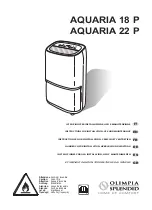
3
IMPORTANT:
READ PRIOR TO STARTING THIS EQUIPMENT
1.0 INSTALLATION
1.1 Location
A. For typical placement in a compressed air system, see
drawing.
B. Air compressor intake–Locate air compressor so that
contaminants potentially harmful to the dryer (e.g.
ammonia) are not drawn into the air system.
C. Dryer should be installed in a moderately heated, well
ventilated area. Avoid locations immediately adjacent
to cold exterior windows or walls, or adjacent to high
temperature ovens or boilers.
D. Clearances: Minimum requirements for free air flow
and service access
Models 25 to 100:
Front 24 inches (610 mm)
Back 24 inches (610 mm)
Sides 12 inches (305 mm)
E. Standard units are designed to operate in ambients:
Air-cooled: 45 to 110
°
F (7 to 43
°
C).
Water-cooled: 45 to 130
°
F (7 to 54
°
C).
F.
Installations in altitudes above 4500 feet (1370
meters) – Dryer is adjusted to operate in altitudes up
to 4500 feet (1370 meters). If dryer is installed in an
altitude above this, and has not been preset at the
factory for this altitude, contact manufacturer’s
Service Department.
G. The installation of a flexible connection prior to the
dryer is recommended to prevent possible damage
from vibration.
NOTE: Outdoor installation–Standard units are designed
for indoor installation. Contact manufacturer if installing
outdoors.
1.2 Mounting
Mount the dryer on a level solid surface. Holes are
provided in the dryer base to permanently mount the
dryer to the floor.
1.3 Piping connections
A. Air Inlet - Connect compressed air line from air
source to air inlet. (See callout drawing on page 3 for
air in/outlet connection locations)
Refer to Serial Number Tag for maximum
working pressure. Do not exceed dryer’s Maximum
Working Pressure.
NOTE:
Install dryer in air system at highest pressure possible
(e.g. before pressure reducing valves).
NOTE:
Install dryer at coolest compressed air temperature
possible. Maximum inlet compressed air temperature:
110
°
F (43
°
C). If inlet air exceeds this temperature, precool
the air with an aftercooler.
B. Air Outlet—Connect air outlet to downstream
air lines.
C. By-pass piping—
If servicing the dryer without interrupting the
air supply is desired, piping should include
inlet and outlet valves and an air by-pass valve.
Power Cord
Separator/Filter
Air Flow
On/Off Switch
Power On-Light
Compressor On-Light
Dew point Temperature Indicator
Optional
Cold Coalescing
Filter
Drain
Air Inlet
Air Outlet
Aftercooler
Separator
Dryer
Oil Removal
Filter
Compressor






























